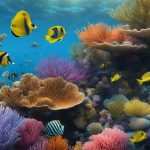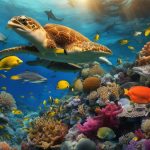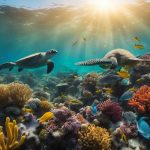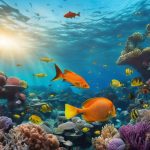Our oceans are essential for sustaining life on our planet, providing us with food, oxygen, and regulating our climate. However, our oceans face numerous threats such as overfishing, climate change, and pollution, which jeopardize the health and survival of marine life and the overall ecosystem. It's time we take action to protect our oceans and marine life through conservation efforts.
Marine conservation refers to the protection and preservation of the oceans and their inhabitants through sustainable practices and conscious efforts to reduce human impact. It is a crucial issue that affects us all, regardless of where we live.
Conservation of oceans is necessary to ensure their longevity and to safeguard the welfare of the millions of species that depend on them. Protecting marine life is not just a moral obligation but a practical one as a healthy ocean ecosystem benefits our economy, health, and wellbeing.
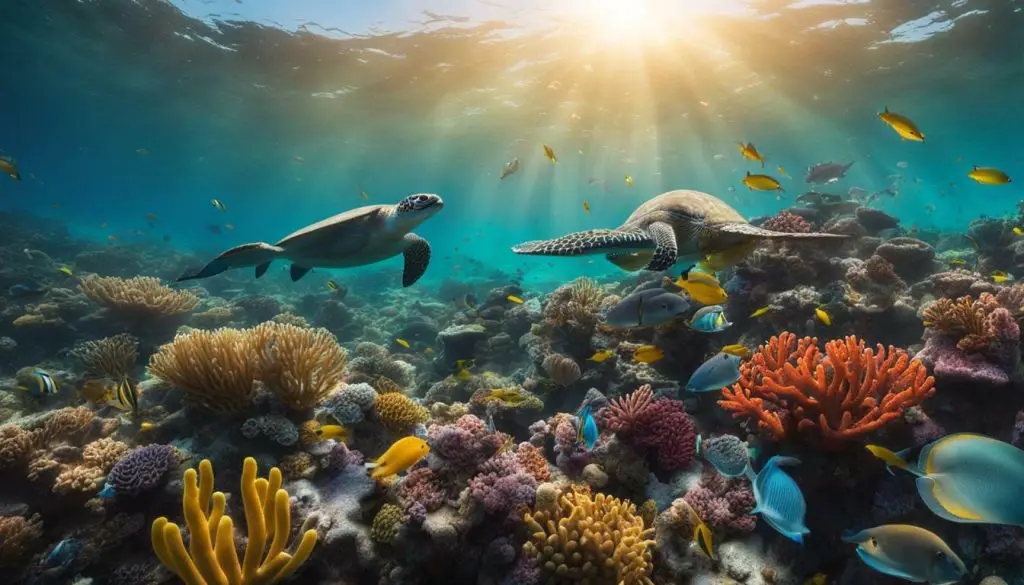
Key Takeaways:
- Marine conservation is crucial for protecting the oceans and their inhabitants.
- Conservation of oceans is necessary for their longevity and the welfare of marine life.
- A healthy ocean ecosystem benefits our economy, health, and wellbeing.
- Taking action to protect our oceans is a moral obligation and a practical necessity.
- Human impact threatens the oceans and their inhabitants.
Sustainable Fishing Practices: Ensuring the Future of our Oceans
The world's oceans are facing numerous threats, including overfishing, climate change, and pollution. The need for sustainable fishing practices has never been greater to protect the marine life and habitats that depend on them. Sustainable fishing practices are those that support the long-term health and productivity of fish populations and their ecosystems.
Responsible fishing techniques such as selective harvesting, fishery management, and reducing bycatch are essential in protecting our marine ecosystems and ensuring food security for future generations. Selective harvesting enables fishermen to catch only certain species and sizes of fish to avoid depleting vulnerable populations, while fishery management involves regulating fishing activities to maintain sustainable levels of fish stocks. Reducing bycatch is the practice of avoiding catching non-target species such as sea turtles, dolphins, and sharks, which are often unintentionally caught in fishing nets.
The adoption of sustainable fishing practices requires a collaborative effort from individuals, the fishing industry, and governments. Regulations and policies need to be put in place to encourage responsible fishing practices, and education and awareness campaigns should be launched to promote sustainable fishing methods.
Sustainable Fishing Practices and Marine Conservation
Sustainable fishing practices play a critical role in marine conservation efforts. By supporting the replenishment of fish stocks and promoting healthy marine ecosystems, sustainable fishing practices can help to maintain the balance of marine food chains, support the livelihoods of fishing communities, and safeguard marine biodiversity.
Furthermore, sustainable fishing practices can reduce pressure on other marine conservation strategies such as marine protected areas, coral reef conservation, and marine pollution solutions. Sustainable fishing practices ensure that fish populations remain healthy, reducing the need for excessive protection measures and preserving their natural habitat.
In conclusion, sustainable fishing practices are a crucial component of marine conservation efforts. The adoption of responsible fishing techniques, the promotion of sustainable fishing methods, and the implementation of regulations and policies are essential in protecting our marine ecosystems and ensuring the future of our oceans.
Coral Reef Conservation: Preserving Biodiversity Hotspots
Coral reefs are incredibly important ecosystems, housing a vast array of marine organisms and providing vital resources and services to human populations around the world.
Unfortunately, coral reefs face numerous threats from human activities, including pollution, overfishing, and climate change-driven phenomena such as coral bleaching. It is estimated that 75% of the world's coral reefs are at risk, and if we do not take action to protect them, they could be lost within our lifetimes.
The importance of coral reef conservation
Conservation efforts are critical for preserving the biodiversity of coral reefs and the many benefits they provide to both marine and human communities.
Coral reefs support an incredible diversity of marine life, including fish, sharks, sea turtles, and countless invertebrates. They also provide coastal protection against storms and wave action, support local economies through tourism and fisheries, and contribute to global climate regulation by absorbing carbon dioxide.
Strategies for coral reef conservation
There are a variety of strategies that can be used to protect and restore coral reefs, including:
- Establishing marine protected areas
- Reducing pollution and sedimentation
- Promoting sustainable tourism practices
- Implementing responsible fishing practices
- Supporting coral restoration initiatives
Marine protected areas (MPAs) can be particularly effective in safeguarding coral reefs and other marine habitats. By limiting human impact within designated zones, MPAs allow ecosystems to recover and thrive. However, effective MPA management and adequate enforcement are crucial to their success.
The way forward
Conserving coral reefs will require a multi-faceted approach that addresses both local and global drivers of degradation. This may include reducing greenhouse gas emissions to mitigate the impacts of climate change, promoting sustainable fishing and tourism practices, and protecting critical habitats through the establishment of marine protected areas.
It is important that governments, communities, and individuals all work together to address the threats facing coral reefs and promote their conservation. By taking action now, we can help ensure that these vital ecosystems continue to thrive for generations to come.
Addressing Marine Pollution: Cleaning Up our Oceans
Marine pollution poses a significant threat to the health of our oceans and the survival of marine life. To address this challenge, innovative solutions are required that not only clean up existing pollution but also prevent future pollution from occurring.
One promising solution is the reduction of plastic waste, particularly single-use plastics such as straws and plastic bags. Governments can implement stricter regulations on plastic production and disposal, while individuals can reduce their own plastic consumption by using reusable bags and containers.
Another approach is to implement more rigorous regulations on industrial waste disposal. Companies can be encouraged to adopt cleaner production methods and reduce their waste output, while governments can enforce stricter penalties for non-compliance.
Public awareness and education campaigns are also critical in addressing marine pollution. By educating individuals about the impact of pollution on marine life and the environment, we can foster a culture of responsibility and encourage sustainable consumption and waste management practices.
"The ocean is not a dumping ground. It is our responsibility to protect it for future generations."
By implementing a combination of these solutions and others, we can work towards a future where our oceans are free from pollution, and marine ecosystems are thriving. Through our collective efforts, we can protect our planet's most precious resource and safeguard the future of marine life.
Ocean Preservation Initiatives: Collaborative Efforts for Change
Marine conservation is a global issue, and as such, requires collaborative efforts to be effective. Through ocean preservation initiatives, organizations and individuals can work together to address the challenges facing our oceans.
“The ocean is a global asset that we all depend on. It’s a shared responsibility.” - Sylvia Earle, Marine Biologist
Marine pollution solutions and establishing marine protected areas are just two examples of the types of initiatives that are being developed to safeguard our oceans. Many of these initiatives are the result of collaborations between government, non-profit organizations, businesses, and concerned citizens.
The United Nations’ Sustainable Development Goals
One significant initiative is the United Nations’ Sustainable Development Goals. These goals aim to provide a framework for sustainable development across the globe, with a specific goal focused on ocean conservation (Goal 14: Life Below Water).
This initiative has led to the creation of various programs, such as the Global Partnership for Oceans, which works to promote sustainable fishing practices and reduce marine pollution. Another partnership, the Ocean Acidification International Coordination Centre, focuses on researching the effects of climate change on our oceans.
The Global Ghost Gear Initiative
Another example of an ocean preservation initiative is The Global Ghost Gear Initiative. This initiative focuses on reducing the amount of “ghost gear” in our oceans. Ghost gear refers to lost or abandoned fishing gear that continues to trap and kill marine life. By bringing together NGOs, industry, and governments, The Global Ghost Gear Initiative has been able to develop effective strategies for mitigating this problem.
The Ocean Cleanup
The Ocean Cleanup is another impressive initiative that is working towards ridding our oceans of plastic pollution. Founded in 2013 by young inventor Boyan Slat, the organization has developed a system to remove plastic waste from our oceans. The initiative has received support from various organizations and governments, highlighting the importance of collaborative efforts in marine conservation.
These are just a few examples of the many ocean preservation initiatives currently being developed to address the challenges facing our oceans. By working together, we can create a more sustainable future for our planet’s marine life.
Marine Habitat Restoration: Restoring Balance to Ecosystems
The degradation of marine habitats is one of the major challenges faced in marine conservation. Fortunately, habitat restoration efforts have the potential to reverse this damage and restore balance to marine ecosystems.
One effective technique is the creation of artificial reefs. These structures provide a habitat for marine life to thrive, including fish, crabs, and other invertebrates. Artificial reefs are typically made from materials such as concrete, rock, and shipwrecks, and are strategically placed in locations where marine life is struggling.
| Benefits of Artificial Reefs |
|---|
| Increase in fish populations |
| Creation of new habitats |
| Attraction for divers and tourists |
Another important technique is the restoration of seagrass beds. Seagrasses are vital to marine ecosystems, providing food and shelter for a wide range of sea creatures. However, these habitats are often damaged by human activities such as dredging and pollution. Restoration efforts may involve replanting seagrass beds or removing obstacles that are impeding their growth.
Similarly, the conservation of mangroves can have a significant impact on marine habitat restoration. Mangroves are important coastal ecosystems that provide a nursery for juvenile fish and protection against coastal erosion.
Overall, marine habitat restoration is critical for protecting marine life and maintaining healthy ecosystems. Efforts to create artificial reefs, restore seagrass beds and conserve mangroves can have a significant impact on the long-term sustainability of our oceans.
Marine Protected Areas: Safeguarding Vital Habitats
Marine protected areas (MPAs) play a crucial role in marine conservation efforts by safeguarding vital habitats and protecting marine life. These areas are designated zones where human activity is restricted or prohibited, allowing ecosystems to thrive and recover from damage caused by human interference.
MPAs are an essential tool in the conservation of marine biodiversity. By designating specific areas as off-limits to harmful human activities, MPAs enable the restoration and preservation of sensitive marine habitats, allowing them to function as crucial nurseries and breeding grounds for a vast array of marine species. These protected areas also help to maintain healthy populations of fish and other marine life, ensuring the continued productivity of ocean ecosystems.
The establishment and management of MPAs require a collaborative effort between government agencies, conservation organizations, and local communities. Effective MPA design and implementation must take into account the needs of all stakeholders and be based on the best available scientific evidence.
The Benefits of Marine Protected Areas
Marine protected areas provide a range of benefits, including:
- Preserving marine biodiversity and protecting endangered species
- Supporting sustainable fisheries management
- Promoting ecotourism and scientific research
- Enhancing the resilience of marine ecosystems
- Protecting cultural heritage sites
The benefits of MPAs extend beyond their immediate geographic boundaries, as healthy ecosystems can have far-reaching impacts on surrounding areas. For example, coral reefs within MPAs can support fisheries outside their boundaries and act as important buffers against storm surges and erosion.
Challenges and Strategies for Effective MPA Management
The establishment and management of MPAs can be challenging, particularly in areas where there are competing interests for space and resources. Additionally, inadequate funding and resources, poor enforcement, and lack of community engagement can undermine the effectiveness of MPAs.
The key to effective MPA management lies in developing a comprehensive approach that takes into account the unique social, economic, and ecological characteristics of each protected area. This includes engaging local communities in decision-making processes, building capacity for MPA management, and ensuring adequate resources for enforcement and monitoring.
Collaboration and cooperation are also crucial for effective MPA management. Governments, conservation organizations, researchers, and local communities must work together to develop and implement policies and strategies that protect marine habitats and promote sustainable use of ocean resources.
By establishing and effectively managing MPAs, we can protect vital marine habitats, safeguard marine life, and ensure the long-term health and productivity of our oceans.
Supporting Marine Biodiversity: Promoting Ecological Balance
Marine biodiversity is critical for the overall health and functioning of our planet's ecosystems. It supports many industries, including tourism, and provides vital resources for millions of people worldwide. However, marine biodiversity faces numerous challenges, including overfishing, habitat degradation, pollution, and climate change.
Marine conservation efforts, such as the establishment of marine protected areas (MPAs), are crucial for the preservation of marine biodiversity. MPAs provide critical habitats for marine species, protect vulnerable ecosystems, and promote sustainable resource management. By reducing human impacts on the ocean, MPAs help to promote ecological balance and support the recovery of degraded habitats.
Supporting marine biodiversity requires a multi-faceted approach. In addition to MPAs, we must also focus on sustainable fishing practices, reducing pollution, and restoring degraded habitats. Promoting ecological balance in the ocean also requires international cooperation and public awareness and education.
One effective strategy for supporting marine biodiversity is through the promotion of sustainable seafood. By choosing sustainably sourced seafood, consumers can help reduce the demand for overexploited species and support responsible fishing practices. Businesses and policymakers can also play a critical role by establishing regulations and incentives that promote sustainable fisheries.
Overall, supporting marine biodiversity is essential for the health and sustainability of our planet. By promoting ecological balance and protecting marine habitats, we can ensure that our oceans continue to provide vital resources and support diverse ecosystems for generations to come.
Conclusion
Protecting our oceans and marine life is crucial for the health and well-being of our planet. In this article, we have explored a range of solutions for marine conservation, including sustainable fishing practices, coral reef conservation, addressing marine pollution, ocean preservation initiatives, marine habitat restoration, marine protected areas, and supporting marine biodiversity.
As individuals, we can take action by reducing our plastic waste, supporting sustainable seafood, and spreading awareness about the importance of marine conservation. Governments, NGOs, and businesses also have a critical role to play in driving change through policy, funding, and collaborative partnerships.
Joining Forces for a Sustainable Future
To ensure the future of our oceans and marine life, we must come together and work towards common goals. By promoting responsible fishing practices, protecting coral reefs, addressing marine pollution, establishing marine protected areas, and supporting marine biodiversity, we can make a significant impact on the health of our oceans.
Let us commit to taking action, individually and collectively, to preserve and protect our marine environments for generations to come.
FAQ
What is marine conservation?
Marine conservation refers to the protection and preservation of ocean ecosystems and the various forms of marine life that inhabit them. It involves efforts to address key challenges such as marine pollution, overfishing, habitat destruction, and climate change in order to maintain the health and sustainability of our oceans.
Why is marine conservation important?
Marine conservation is crucial because our oceans play a vital role in supporting life on Earth. They provide habitat for countless species, produce oxygen, regulate climate, and offer valuable resources. By protecting and preserving marine ecosystems, we help ensure the health and resilience of our planet and secure a sustainable future for generations to come.
What are sustainable fishing practices?
Sustainable fishing practices are methods and techniques designed to minimize the environmental impact of fishing and ensure the long-term viability of fish populations. These practices focus on strategies such as selective harvesting, fishery management, and reducing bycatch to promote responsible fishing and protect marine biodiversity.
How can we conserve coral reefs?
Conserving coral reefs involves a range of strategies, such as establishing marine protected areas, promoting sustainable tourism practices, and implementing measures to reduce coral bleaching and destructive fishing practices. Additionally, initiatives like coral restoration and replanting efforts can help restore damaged reef ecosystems and preserve their unique biodiversity.
What can be done to address marine pollution?
Various solutions can be implemented to address marine pollution. These include reducing plastic waste through proper waste management and recycling, implementing stricter regulations on industrial waste disposal, promoting public awareness and education about the impacts of pollution, and supporting innovative technologies for cleaning up and preventing further pollution.
How are marine protected areas beneficial?
Marine protected areas (MPAs) play a vital role in marine conservation. They provide safe havens for marine species, preserve critical habitats, and support the recovery of ecosystems. MPAs also promote sustainable resource management, help combat overfishing, and contribute to the overall health and resilience of marine environments.
What can individuals do to support marine conservation?
Individuals can make a difference by reducing their use of single-use plastics, supporting sustainable seafood choices, participating in beach cleanups, and spreading awareness about the importance of marine conservation. Supporting organizations and initiatives dedicated to marine protection, and advocating for government policies and regulations that prioritize ocean health, are also impactful ways to contribute.
Latest Posts
- Royal Windermere Yacht Club Review
 Did you know Lake Windermere is England's biggest lake? It's 10.5 miles long and 1 mile wide. This beautiful lake is home to the famous Royal Windermere Yacht Club. It's one of the UK's top sailing clubs, making it a great spot for sailing fans and those who love being on the water. The Royal… Read more: Royal Windermere Yacht Club Review
Did you know Lake Windermere is England's biggest lake? It's 10.5 miles long and 1 mile wide. This beautiful lake is home to the famous Royal Windermere Yacht Club. It's one of the UK's top sailing clubs, making it a great spot for sailing fans and those who love being on the water. The Royal… Read more: Royal Windermere Yacht Club Review - Coquet Yacht Club Review
 Welcome to the Coquet Yacht Club in Amble, UK. It's known for its yachting community and great marina. Also, see why this club is so well-loved. The Coquet Yacht Club has over 500 members who love boating. They come from many different backgrounds but share a passion for sailing. This club has a long history… Read more: Coquet Yacht Club Review
Welcome to the Coquet Yacht Club in Amble, UK. It's known for its yachting community and great marina. Also, see why this club is so well-loved. The Coquet Yacht Club has over 500 members who love boating. They come from many different backgrounds but share a passion for sailing. This club has a long history… Read more: Coquet Yacht Club Review - Coniston Sailing Club Review
 Did you know about the Coniston Sailing Club in the stunning Lake District? It offers many services and activities for all sailing lovers. The club's beautiful location and great facilities make it a top pick for sailing in the UK. At Coniston Sailing Club, you can learn to sail, hire a boat, or join fun… Read more: Coniston Sailing Club Review
Did you know about the Coniston Sailing Club in the stunning Lake District? It offers many services and activities for all sailing lovers. The club's beautiful location and great facilities make it a top pick for sailing in the UK. At Coniston Sailing Club, you can learn to sail, hire a boat, or join fun… Read more: Coniston Sailing Club Review - St Andrews Sailing Club Review
 Did you know sailing is growing fast in the UK? More people are discovering the joy of sailing. If you love sailing or want to learn, check out St Andrews Sailing Club. The club has something for everyone. From beginners to experts, you can learn and have fun. Their instructors teach you everything about sailing… Read more: St Andrews Sailing Club Review
Did you know sailing is growing fast in the UK? More people are discovering the joy of sailing. If you love sailing or want to learn, check out St Andrews Sailing Club. The club has something for everyone. From beginners to experts, you can learn and have fun. Their instructors teach you everything about sailing… Read more: St Andrews Sailing Club Review - Derwent Reservoir Sailing Club Review
 Did you know that Derwent Reservoir in Northumberland is famous for both calm walks and exciting water sports? The Derwent Reservoir Sailing Club is loved by many. Families, water sports fans, and those who love adventure come here. The club is in Blanchland, Consett, a nice place for all. Imagine paddle boarding, dinghy sailing, windsurfing,… Read more: Derwent Reservoir Sailing Club Review
Did you know that Derwent Reservoir in Northumberland is famous for both calm walks and exciting water sports? The Derwent Reservoir Sailing Club is loved by many. Families, water sports fans, and those who love adventure come here. The club is in Blanchland, Consett, a nice place for all. Imagine paddle boarding, dinghy sailing, windsurfing,… Read more: Derwent Reservoir Sailing Club Review - Loch Venachar Sailing Club Review
 Welcome to Loch Venachar Sailing Club, an exciting place! Loch Venachar is in the Trossachs National Park, a top spot in the Scottish Highlands for sailing fans. This club teems with beautiful sights and fun activities, making it a perfect spot for all. Join in the fun at Loch Venachar Sailing Club with sailing lessons… Read more: Loch Venachar Sailing Club Review
Welcome to Loch Venachar Sailing Club, an exciting place! Loch Venachar is in the Trossachs National Park, a top spot in the Scottish Highlands for sailing fans. This club teems with beautiful sights and fun activities, making it a perfect spot for all. Join in the fun at Loch Venachar Sailing Club with sailing lessons… Read more: Loch Venachar Sailing Club Review - Cardwell Bay Sailing Club Review
 Did you know that sailing is not just thrilling, but also helps you see the coast's beauty? It is well-loved by water lovers around the world. Cardwell Bay Sailing Club is here for you, offering amazing sailing adventures. The club is at the gorgeous Cardwell Bay marina. It's perfect for beginners and experienced sailors alike.… Read more: Cardwell Bay Sailing Club Review
Did you know that sailing is not just thrilling, but also helps you see the coast's beauty? It is well-loved by water lovers around the world. Cardwell Bay Sailing Club is here for you, offering amazing sailing adventures. The club is at the gorgeous Cardwell Bay marina. It's perfect for beginners and experienced sailors alike.… Read more: Cardwell Bay Sailing Club Review - Clyde Corinthian Yacht Club Review
 Did you know the Clyde Corinthian Yacht Club is over 140 years old? Since 1877, this club on the west coast of Scotland has welcomed sailing fans. It's a place where both new and experienced sailors come together. The club is known worldwide for its excellence in sailing. The club has great facilities like a… Read more: Clyde Corinthian Yacht Club Review
Did you know the Clyde Corinthian Yacht Club is over 140 years old? Since 1877, this club on the west coast of Scotland has welcomed sailing fans. It's a place where both new and experienced sailors come together. The club is known worldwide for its excellence in sailing. The club has great facilities like a… Read more: Clyde Corinthian Yacht Club Review - Ullswater Yacht Club Review
 The Lake District isn't just about beautiful views. It's also a top place for sailing. Ullswater Yacht Club brings together sailing fans to enjoy the calm and excitement of sailing. It sits in the lovely Lake District. Here, you can join regattas, rent boats, or take sailing classes. This club is known for its great… Read more: Ullswater Yacht Club Review
The Lake District isn't just about beautiful views. It's also a top place for sailing. Ullswater Yacht Club brings together sailing fans to enjoy the calm and excitement of sailing. It sits in the lovely Lake District. Here, you can join regattas, rent boats, or take sailing classes. This club is known for its great… Read more: Ullswater Yacht Club Review - Prestwick Sailing Club Review
 Did you know over 1.5 million people in the UK love sailing and water sports? Among these, Prestwick Sailing Club is a top choice. It's on the beautiful Ayrshire coast. Here, you can enjoy various activities, no matter your skill level. The club offers sailing lessons, boat rentals, and a great clubhouse. It also hosts… Read more: Prestwick Sailing Club Review
Did you know over 1.5 million people in the UK love sailing and water sports? Among these, Prestwick Sailing Club is a top choice. It's on the beautiful Ayrshire coast. Here, you can enjoy various activities, no matter your skill level. The club offers sailing lessons, boat rentals, and a great clubhouse. It also hosts… Read more: Prestwick Sailing Club Review - Clyde Cruising Club Review
 Did you know the Clyde Cruising Club started in 1909? It's one of Scotland's most respected sailing clubs in Scotland. For over a century, it has been central to the area's boating history and known for its wonderful sailing experiences. In the lively city of Glasgow, the Clyde Cruising Club is a key point for… Read more: Clyde Cruising Club Review
Did you know the Clyde Cruising Club started in 1909? It's one of Scotland's most respected sailing clubs in Scotland. For over a century, it has been central to the area's boating history and known for its wonderful sailing experiences. In the lively city of Glasgow, the Clyde Cruising Club is a key point for… Read more: Clyde Cruising Club Review - Dalgety Bay Sailing Club Review
 On the north shore of the Firth of Forth, about three miles east of the Forth Rail Bridge, you'll find Dalgety Bay Sailing Club nestled in its own spacious coastal area with a convenient high tide access harbour. The WyndDalgety BayDunfermlineFifeKY11 9SJ Author John Sixthsmith I'm a freelance writer and avid sailor who loves to… Read more: Dalgety Bay Sailing Club Review
On the north shore of the Firth of Forth, about three miles east of the Forth Rail Bridge, you'll find Dalgety Bay Sailing Club nestled in its own spacious coastal area with a convenient high tide access harbour. The WyndDalgety BayDunfermlineFifeKY11 9SJ Author John Sixthsmith I'm a freelance writer and avid sailor who loves to… Read more: Dalgety Bay Sailing Club Review - Royal Forth Yacht Club Review
 The Royal Forth Yacht Club is a well-established water-sports club with over 150 years of history. Located in Granton Harbour near Edinburgh, the Club offers easy access to the beautiful sailing waters of the Firth of Forth. Members can participate in a variety of racing and cruising activities, with access to fully serviced moorings and… Read more: Royal Forth Yacht Club Review
The Royal Forth Yacht Club is a well-established water-sports club with over 150 years of history. Located in Granton Harbour near Edinburgh, the Club offers easy access to the beautiful sailing waters of the Firth of Forth. Members can participate in a variety of racing and cruising activities, with access to fully serviced moorings and… Read more: Royal Forth Yacht Club Review - Port Edgar Yacht Club Review
 Port Edgar Yacht Club is situated in South Queensferry, near the iconic Forth Bridges, making it easily accessible within a 60-minute drive for most individuals in the Central Belt. Whether you are new to the area, have recently completed an RYA course, or simply wish to return to sailing, they are there to assist you.… Read more: Port Edgar Yacht Club Review
Port Edgar Yacht Club is situated in South Queensferry, near the iconic Forth Bridges, making it easily accessible within a 60-minute drive for most individuals in the Central Belt. Whether you are new to the area, have recently completed an RYA course, or simply wish to return to sailing, they are there to assist you.… Read more: Port Edgar Yacht Club Review - Cramond Boat Club Review
 The Cramond Boat Club is located at the mouth of the River Almond, just four miles from the bustling centre of Edinburgh. Our Clubhouse and moorings provide a welcoming home for a variety of small craft, from dinghies to small cruisers and motorboats. The River Almond offers tidal access to the Firth of Forth for… Read more: Cramond Boat Club Review
The Cramond Boat Club is located at the mouth of the River Almond, just four miles from the bustling centre of Edinburgh. Our Clubhouse and moorings provide a welcoming home for a variety of small craft, from dinghies to small cruisers and motorboats. The River Almond offers tidal access to the Firth of Forth for… Read more: Cramond Boat Club Review - Discover Dinghy Sailing Holidays Adventure!
 Are you ready for an unforgettable vacation experience? Imagine gliding across crystal-clear waters, feeling the wind in your hair, and exploring hidden coves and breath-taking coastlines. Dinghy sailing holidays offer a unique adventure that brings together the thrill of sailing with the serenity of being surrounded by nature. But what exactly are dinghy sailing holidays… Read more: Discover Dinghy Sailing Holidays Adventure!
Are you ready for an unforgettable vacation experience? Imagine gliding across crystal-clear waters, feeling the wind in your hair, and exploring hidden coves and breath-taking coastlines. Dinghy sailing holidays offer a unique adventure that brings together the thrill of sailing with the serenity of being surrounded by nature. But what exactly are dinghy sailing holidays… Read more: Discover Dinghy Sailing Holidays Adventure! - Experience the Majesty: Sailing Alaska Adventures
 Are you ready to set sail and discover the untamed beauty of Alaska? Have you ever wondered what it's like to navigate through icy fjords, witness breathtaking wildlife, and experience the thrill of the open sea in one of the most awe-inspiring destinations on Earth? Get ready for an unforgettable adventure as we take you… Read more: Experience the Majesty: Sailing Alaska Adventures
Are you ready to set sail and discover the untamed beauty of Alaska? Have you ever wondered what it's like to navigate through icy fjords, witness breathtaking wildlife, and experience the thrill of the open sea in one of the most awe-inspiring destinations on Earth? Get ready for an unforgettable adventure as we take you… Read more: Experience the Majesty: Sailing Alaska Adventures - Set Sail on Learn to Sail Holidays Adventure
 Are you ready to embark on an unforgettable adventure and discover the thrill of sailing? Imagine mastering the art of navigating the open waters while exploring breathtaking destinations around the world. Whether you're a beginner or have some sailing experience, learn to sail holidays offer the perfect opportunity to embark on a new voyage of… Read more: Set Sail on Learn to Sail Holidays Adventure
Are you ready to embark on an unforgettable adventure and discover the thrill of sailing? Imagine mastering the art of navigating the open waters while exploring breathtaking destinations around the world. Whether you're a beginner or have some sailing experience, learn to sail holidays offer the perfect opportunity to embark on a new voyage of… Read more: Set Sail on Learn to Sail Holidays Adventure - Greek Sailing Holidays – Unwind on the Aegean
 Have you ever dreamed of sailing through the turquoise waters of the Aegean Sea, exploring the enchanting Greek islands at your own pace? Picture yourself immersing in the captivating beauty of hidden coves, basking in the warm Mediterranean sun, and experiencing the rich cultural heritage that Greece has to offer. Well, it's time to turn… Read more: Greek Sailing Holidays – Unwind on the Aegean
Have you ever dreamed of sailing through the turquoise waters of the Aegean Sea, exploring the enchanting Greek islands at your own pace? Picture yourself immersing in the captivating beauty of hidden coves, basking in the warm Mediterranean sun, and experiencing the rich cultural heritage that Greece has to offer. Well, it's time to turn… Read more: Greek Sailing Holidays – Unwind on the Aegean - Understanding What Are Marine Conservation Areas: A Guide
 Marine conservation areas are protected ocean spaces designated to preserve marine environments and their inhabitants. These areas are established to help regulate human activities and promote sustainable practices that maintain the health and productivity of ocean ecosystems. Marine conservation areas play a crucial role in preserving marine biodiversity and protecting vulnerable species. By designating specific… Read more: Understanding What Are Marine Conservation Areas: A Guide
Marine conservation areas are protected ocean spaces designated to preserve marine environments and their inhabitants. These areas are established to help regulate human activities and promote sustainable practices that maintain the health and productivity of ocean ecosystems. Marine conservation areas play a crucial role in preserving marine biodiversity and protecting vulnerable species. By designating specific… Read more: Understanding What Are Marine Conservation Areas: A Guide - Exploring Success Stories with Marine Conservation: Key Insights
 In recent years, marine conservation efforts have gained significant momentum, with organizations and individuals around the world taking action to restore the health of our oceans and protect marine life. In this article, we will delve into inspiring examples of marine conservation and showcase successful marine conservation projects through case studies and real-life stories. We… Read more: Exploring Success Stories with Marine Conservation: Key Insights
In recent years, marine conservation efforts have gained significant momentum, with organizations and individuals around the world taking action to restore the health of our oceans and protect marine life. In this article, we will delve into inspiring examples of marine conservation and showcase successful marine conservation projects through case studies and real-life stories. We… Read more: Exploring Success Stories with Marine Conservation: Key Insights - Solutions Explored: What Can We Do About Marine Conservation
 Our oceans are essential for sustaining life on our planet, providing us with food, oxygen, and regulating our climate. However, our oceans face numerous threats such as overfishing, climate change, and pollution, which jeopardize the health and survival of marine life and the overall ecosystem. It's time we take action to protect our oceans and… Read more: Solutions Explored: What Can We Do About Marine Conservation
Our oceans are essential for sustaining life on our planet, providing us with food, oxygen, and regulating our climate. However, our oceans face numerous threats such as overfishing, climate change, and pollution, which jeopardize the health and survival of marine life and the overall ecosystem. It's time we take action to protect our oceans and… Read more: Solutions Explored: What Can We Do About Marine Conservation - Discover Who is the Father of Marine Conservation Today
 Environmental preservation has become a pressing issue in recent times, with marine conservation at the forefront of efforts to protect our oceans and marine life. It is only through the tireless efforts of pioneers, trailblazers, and visionaries that we have come to understand the critical importance of preserving our planet's marine ecosystems. In this section,… Read more: Discover Who is the Father of Marine Conservation Today
Environmental preservation has become a pressing issue in recent times, with marine conservation at the forefront of efforts to protect our oceans and marine life. It is only through the tireless efforts of pioneers, trailblazers, and visionaries that we have come to understand the critical importance of preserving our planet's marine ecosystems. In this section,… Read more: Discover Who is the Father of Marine Conservation Today - Understanding What Are Marine Conservation Zones: A Guide
 Marine ecosystems cover more than two-thirds of our planet and are an essential part of our lives. They provide us with food, oxygen, and countless other resources. However, human activities such as overfishing, pollution, and habitat destruction have put immense pressure on these ecosystems, threatening their health and sustainability. To address these issues, marine conservation… Read more: Understanding What Are Marine Conservation Zones: A Guide
Marine ecosystems cover more than two-thirds of our planet and are an essential part of our lives. They provide us with food, oxygen, and countless other resources. However, human activities such as overfishing, pollution, and habitat destruction have put immense pressure on these ecosystems, threatening their health and sustainability. To address these issues, marine conservation… Read more: Understanding What Are Marine Conservation Zones: A Guide - Understanding What is Marine Conservation: A Quick Guide
 Marine conservation refers to the protection and preservation of marine ecosystems and the species that inhabit them. It involves various efforts made by organizations and individuals to ensure the long-term sustainability of our valuable marine resources. Marine conservation strategies aim to reduce the negative impacts of human activities on marine ecosystems, such as overfishing, habitat… Read more: Understanding What is Marine Conservation: A Quick Guide
Marine conservation refers to the protection and preservation of marine ecosystems and the species that inhabit them. It involves various efforts made by organizations and individuals to ensure the long-term sustainability of our valuable marine resources. Marine conservation strategies aim to reduce the negative impacts of human activities on marine ecosystems, such as overfishing, habitat… Read more: Understanding What is Marine Conservation: A Quick Guide




















